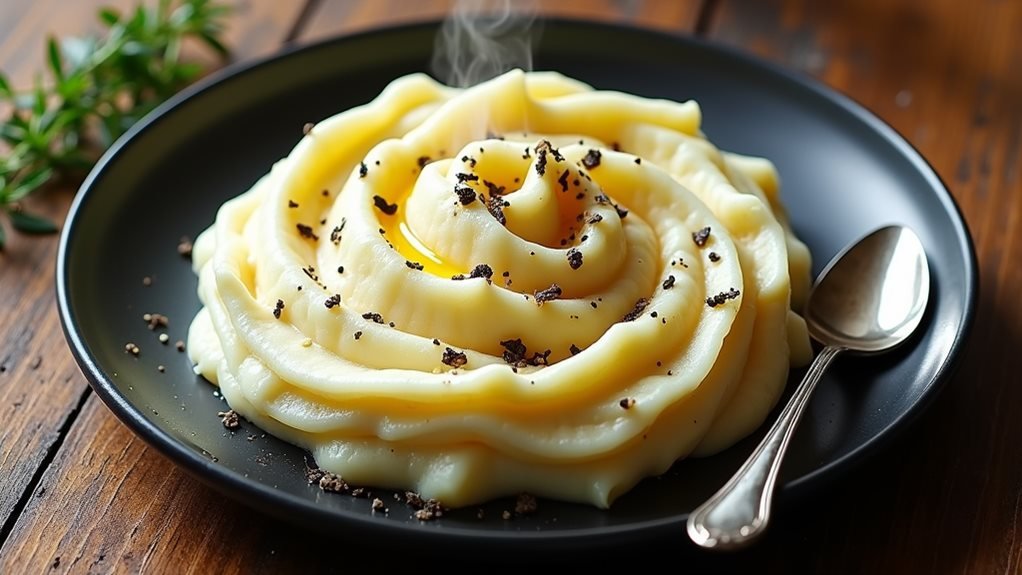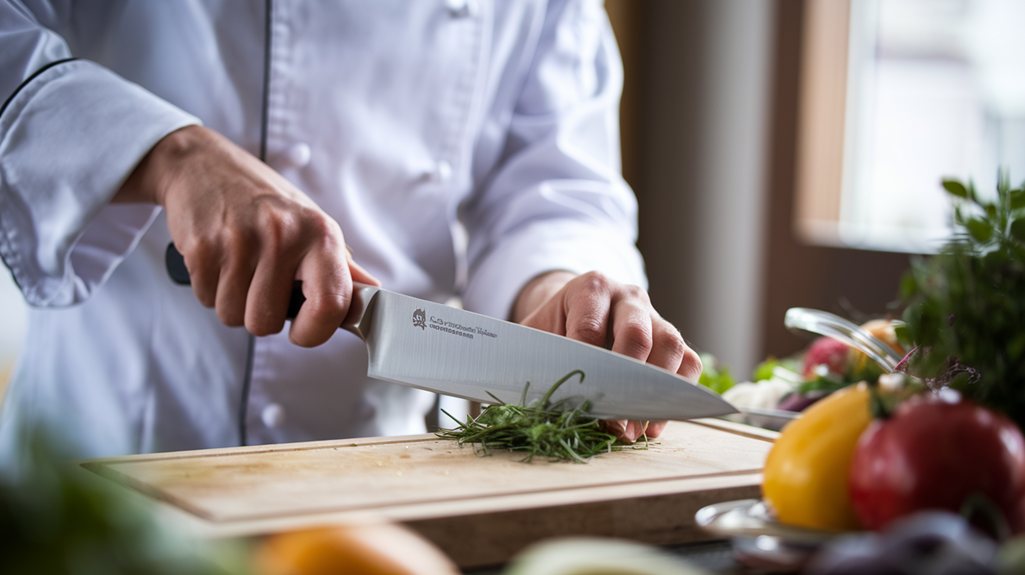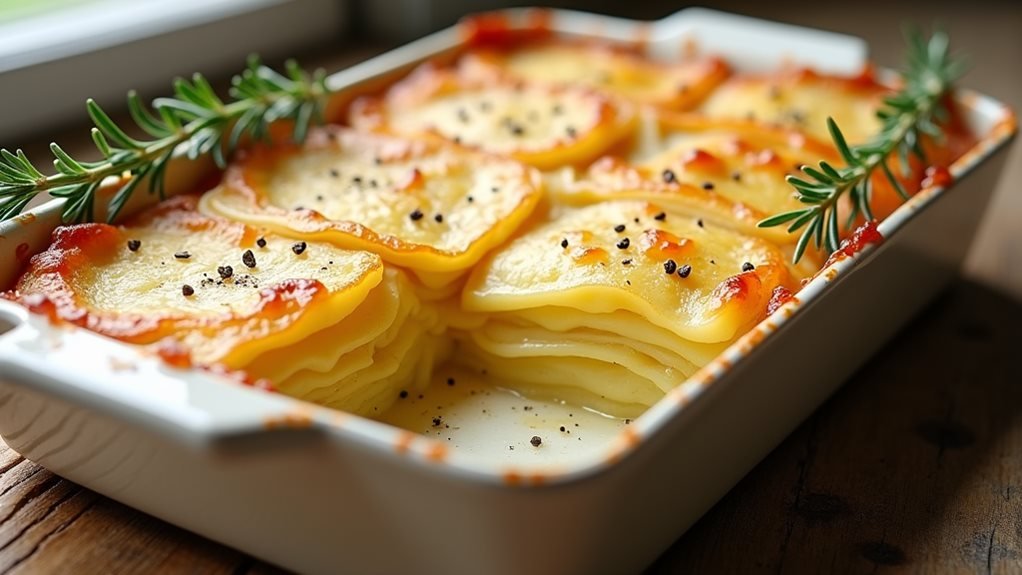While truffles were historically sought using female pigs due to their natural ability to detect the fungi’s scent compounds, you’ll find that modern truffle hunters prefer dogs for their less destructive harvesting methods. This prized ingredient transforms ordinary mashed potatoes into a sophisticated side dish worthy of any fine dining establishment, and you don’t need to be a top-tier chef to master it. By understanding the delicate balance of flavors and proper techniques that Gordon Ramsay himself employs, you can lift this comfort food classic into something truly exceptional.
Recipe Insights
- Start with Yukon Gold potatoes and boil them in cold, salted water until fork-tender for even cooking and rich flavor.
- Rice the potatoes while hot using the smallest disc of a potato ricer. Never use food processors or electric mixers.
- Heat heavy cream and butter separately before incorporating into potatoes to maintain optimal temperature and silky texture.
- Fold in premium white truffle oil at the final stage to preserve the delicate aroma and luxurious flavor.
- Finish with Maldon sea salt, freshly cracked black pepper, and fresh chives for a restaurant-quality presentation.
History
The fusion of truffles with mashed potatoes emerged in European fine dining during the early 20th century, when French chefs began experimenting with ways to incorporate luxury ingredients into everyday dishes.
This combination quickly became a staple in high-end restaurants across Paris, where wealthy patrons sought innovative takes on familiar comfort foods.
By the 1950s, truffle mashed potatoes appeared on menus throughout Europe’s finest establishments, though the dish remained largely inaccessible to home cooks due to the scarcity and cost of fresh truffles.
The introduction of truffle oil in the 1980s transformed how you could prepare this luxurious side dish at home. While purists initially resisted the use of truffle oil, it’s now become widely accepted as a practical alternative to fresh truffles.
Today, truffle mashed potatoes have evolved into countless variations, with chefs adding their own unique touches. Whether you’re serving them at a holiday gathering or preparing a special dinner, they’ve maintained their status as a symbol of culinary refinement, bridging the gap between rustic comfort food and haute cuisine.
Many chefs enhance their truffle mashed potatoes with traditional vinaigrette combinations of oil, vinegar, and seasonings to add depth to the flavor profile.
Recipe
Truffle-whipped potatoes transform typical spuds into a sophisticated side dish that pairs exquisitely with any main course. The fusion of velvety Yukon Gold potatoes and fragrant truffle oil creates a lavish blend that raises this comforting dish classic to new levels.
The key to achieving the perfect truffle whipped potatoes lies in the technique and timing. Utilizing warm cream and butter guarantees the potatoes remain hot while mixing, and incorporating the truffle oil at the final stage maintains its delicate flavor profile while infusing the dish with its distinctive earthy notes.
- 2 pounds Yukon Gold potatoes
- 1 cup heavy cream
- 8 tablespoons unsalted butter
- 2 tablespoons white truffle oil
- Sea salt to taste
Peel and quarter the potatoes, then place them in a pot of cold salted water and bring them to a boil. Cook until tender, about 20 minutes. While the potatoes are cooking, warm the cream and butter in a small saucepan until the butter melts completely. Drain the cooked potatoes and return to the pot. Pass them through a ricer or food mill back into the pot. Gradually fold in the warm cream mixture while stirring with a wooden spoon. Once smooth and creamy, stir in the truffle oil and season with salt to taste.
For best results, never use an electric mixer or food processor, as this can make the potatoes gummy and ruin their natural texture. Always start the potatoes in cold water to guarantee even cooking, and make sure to warm the cream and butter before adding them to the potatoes. If the finished potatoes become too thick, thin them with additional warm cream. The truffle oil should always be added last, as heating it can lessen its flavor. Like many restaurant-quality potatoes, this recipe uses generous amounts of butter and cream to achieve that professional taste and texture.
Cooking Steps
You’ll want to start by peeling and cutting your potatoes into quarters before boiling them in salted water until they’re easily pierced with a fork.
While the potatoes cook, warm the cream and butter mixture in a separate pan. Then, pass the drained potatoes through a ricer or food mill for the smoothest texture.
Ultimately, you’ll incorporate the warmed cream mixture and truffle oil into your riced potatoes, stirring gently until you’ve achieved a silky, uniform consistency.
Step 1. Peel and Quarter Potatoes
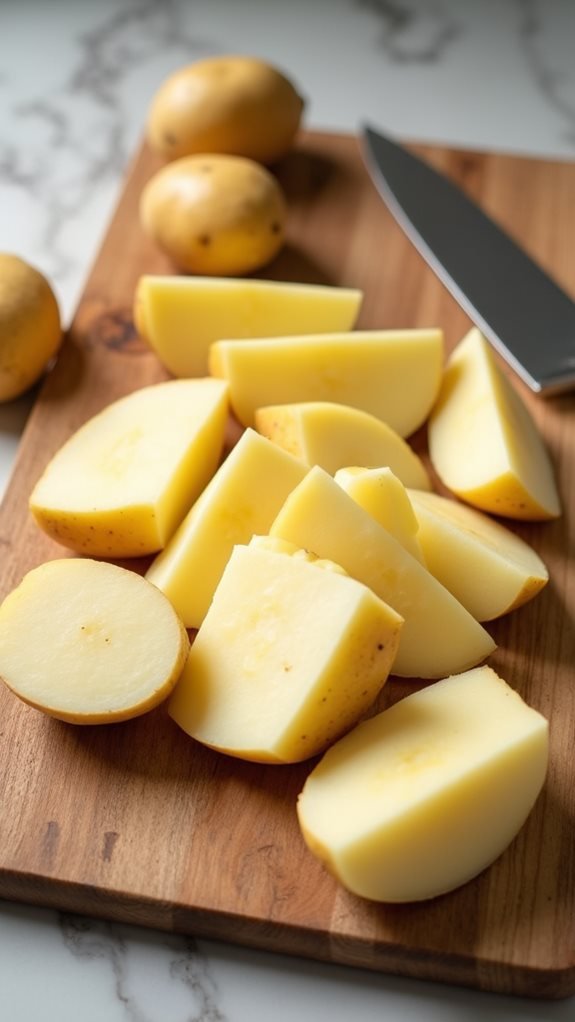
Before starting the cooking process, rinse your Yukon Gold potatoes thoroughly under cold water and pat them dry. This recipe calls for two pounds of potatoes, which typically equals 6-8 medium-sized spuds. Place them on a clean cutting board with a sharp knife at the ready.
Using a vegetable peeler, remove the skin completely from each potato, making sure you don’t leave any brown spots or eyes behind. While peeling, inspect each potato for any green areas or blemishes that you’ll need to cut away.
Once peeled, cut each potato in half lengthwise, then cut each half into two equal pieces, creating quarters that are roughly the same size. This uniform sizing is essential for even cooking.
As you quarter each potato, immediately place the pieces into a bowl of cold water to prevent oxidation, which can lead to discoloration.
When you’re ready to cook, drain the quartered potatoes and transfer them to your cooking pot. Remember, starting with cold water helps guarantee the potatoes cook evenly from the inside out.
Step 2. Boil Potatoes Until Fork-Tender

After draining the quartered potatoes from their cold water bath, place them in a large pot and add enough fresh cold water to cover them by about an inch. Add a generous pinch of salt to the water – about 1 tablespoon per quart – as this will season the potatoes from the inside out while they cook. Place the pot over high heat and bring the water to a rolling boil.
Once boiling, reduce the heat to medium-high to maintain a steady simmer. You’ll want to cook the potatoes for approximately 20-25 minutes, but don’t rely solely on timing. Instead, test for doneness by inserting a fork into the center of the largest potato piece. When it slides in and out without resistance, the potatoes are perfectly tender.
Don’t overcook them, as waterlogged potatoes will become gummy when mashed. If you notice the potatoes are cooking unevenly, gently stir them once or twice during the cooking process. When they’re done, drain them immediately in a colander, giving them a gentle shake to remove excess water.
Step 3. Warm Milk and Butter
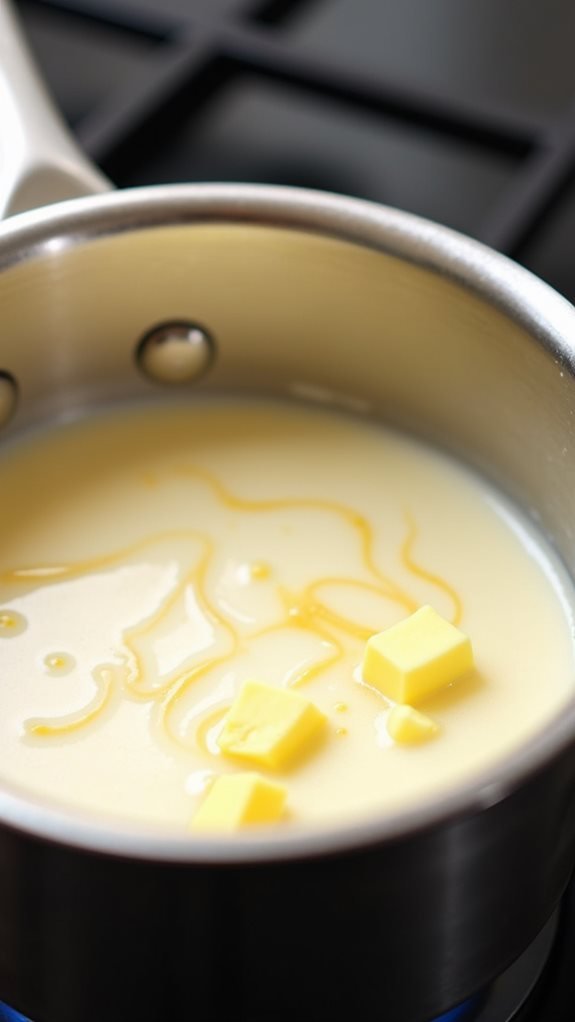
The next significant step in creating velvety mashed potatoes involves heating the dairy components. While your potatoes are boiling, combine the heavy cream and butter in a small saucepan over medium-low heat. This vital step guarantees your mashed potatoes won’t lose their temperature when you blend these ingredients later.
As you warm the mixture, you’ll want to keep a vigilant eye on it, stirring occasionally to prevent the cream from scorching. You want the butter to melt completely and merge with the cream, creating a consistent, warm liquid that’s ready to be folded into your potatoes.
The temperature should be hot but not boiling – around 180°F if you’re using a thermometer. If you’ve timed it right, your dairy mixture will be ready just as your potatoes finish cooking.
Don’t make the common mistake of adding cold dairy to your potatoes. This will result in a suboptimal texture and temperature. The warm mixture will help the potatoes absorb the liquid more efficiently, creating that high-quality smoothness you’re aiming for.
Step 4. Rice Potatoes Until Smooth
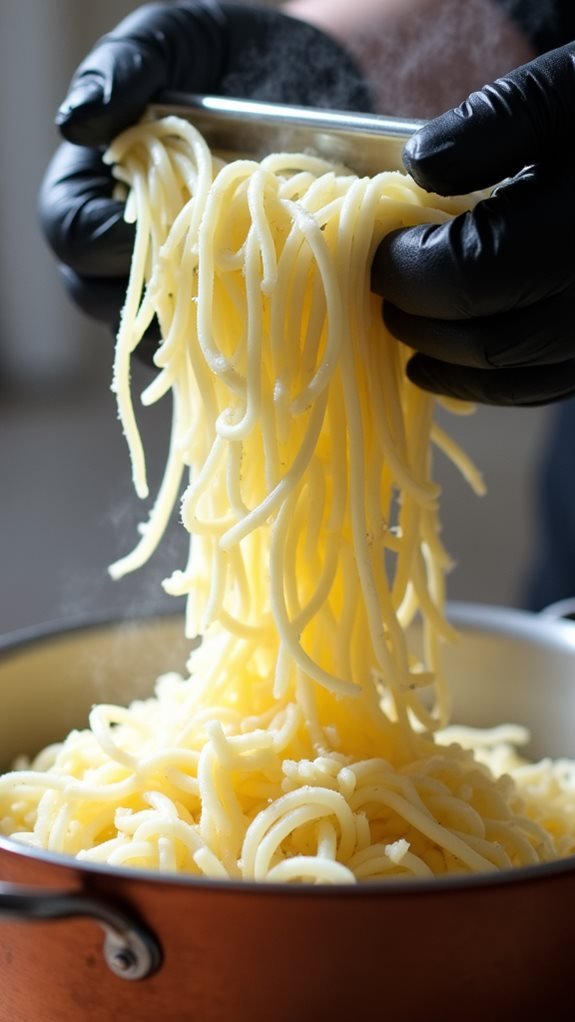
Once your potatoes are thoroughly cooked and drained, you’ll need to pass them through a potato ricer or food mill while they’re still hot. This pivotal step creates the silky-smooth texture that distinguishes exceptional mashed potatoes from ordinary ones, as the ricer eliminates all lumps while preventing the potatoes from becoming gummy or overworked.
Working in batches, place the hot potato pieces into your ricer’s hopper and press them through with steady, even pressure. You’ll notice the potatoes emerging in fine, rice-like strands that will easily incorporate with other ingredients.
If you’re using a food mill, select the disc with the smallest holes and turn the handle at a consistent speed to achieve the same results. Don’t be tempted to use a food processor or blender, as these appliances will rupture too many starch cells, resulting in a gluey consistency that’s impossible to rescue.
After ricing, return the potatoes to the warm pot and immediately incorporate the heated cream mixture to maintain the ideal serving temperature.
sStep5. Stir in Truffle Oil
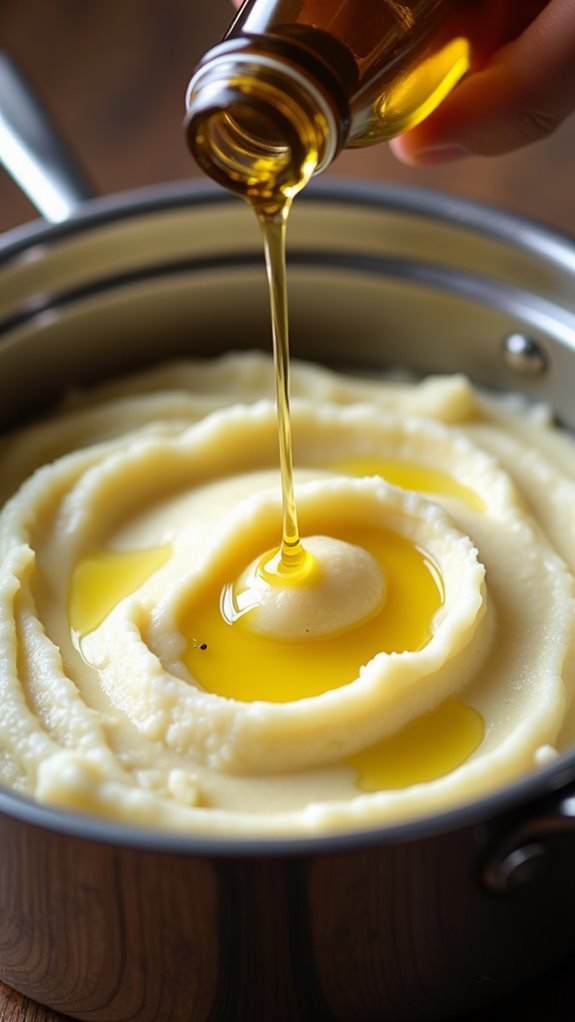
Now that your potatoes have reached velvety perfection through ricing, it’s time to incorporate the star ingredient—truffle oil. Drizzle in two tablespoons of white truffle oil while gently folding the potatoes with a wooden spoon, ensuring even distribution throughout the mixture.
When working with truffle oil, timing is essential. Add it after you’ve incorporated the warm cream and butter, but just before serving. This preserves the oil’s delicate, earthy aroma that’ll enchant your guests’ senses. If you’re preparing the dish in advance, wait to add the truffle oil until the final reheating – it’s worth the extra step to maintain its distinct character.
As you stir, the truffle oil’s rich fragrance will begin to blossom. Continue folding until you’ve achieved a uniform consistency, being careful not to overmix.
You can adjust the amount of truffle oil based on your preference, but keep in mind that its flavor is potent—start with less, as you can always add more. The finished potatoes should have a harmonious taste where the truffle essence complements, rather than overpowers, the natural potato flavor.
Common Questions About This Recipe
When preparing truffle mashed potatoes for the first time, home cooks often ask about key techniques and ingredient substitutions. Most questions center around potato selection, truffle oil quality, and making adjustments for dietary restrictions.
If you can’t source Yukon Gold potatoes, you can substitute Russet potatoes, though you’ll need to adjust the cream ratio slightly to achieve the same silky texture.
For those asking about dairy alternatives, you can use plant-based milk and vegan butter, but you’ll want to warm them together just as you’d the traditional ingredients.
The most frequent question concerns truffle oil selection. You’ll want to invest in high-quality white truffle oil from a reputable source, as synthetic versions won’t deliver the same depth of flavor.
If you’re making these ahead of time, you can prepare the basic mashed potatoes up to two days in advance but don’t add the truffle oil until just before serving.
For those concerned about portion sizes, this recipe typically serves 6-8 people generously, and you can easily scale it up or down by maintaining the same ratios.
Final Thoughts and Serving Ideas
Truffle mashed potatoes stand up to even the most elegant main courses, from roasted prime rib to seared scallops. They are particularly impressive when served alongside beef tenderloin, rack of lamb, or pan-seared duck breast. Their luxurious texture and sophisticated flavor profile make them an outstanding choice for special occasions and holiday gatherings.
When you’re ready to serve, consider presenting these potatoes in warm bowls to maintain their ideal temperature. Using the back of a spoon, you can create an elegant swirl pattern on top. Then, drizzle with a touch more truffle oil and garnish with fresh chives or microgreens.
If you’re serving a crowd, keep them warm in a covered dish set over a water bath. They’ll maintain their creamy consistency for up to two hours.
Don’t hesitate to customize the garnishes based on your main course. Fresh herbs like thyme or rosemary complement meat dishes beautifully, while a light dusting of freshly grated Parmesan adds an extra layer of umami that your guests won’t soon forget.
